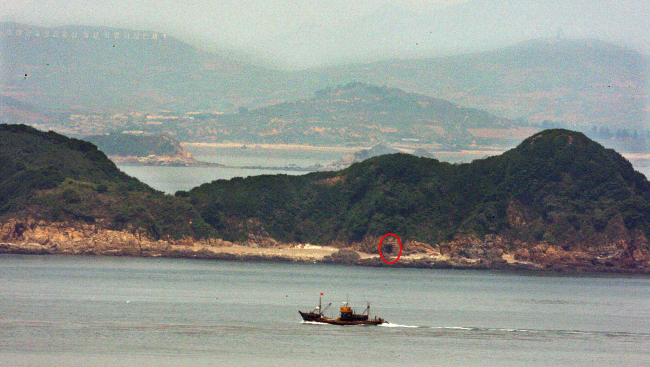North Korea’s recent deployment of four multiple rocket launchers on a border island is raising questions whether South Korea is sufficiently prepared to handle threats from these rockets and other artillery targeting Seoul and its surrounding areas.
 |
| This file photo shows North Korea’s forward-deployed artillery piece, marked with a red circle, at its border island of Galdo, 4.5 km from South Korea’s Yeonpyeongdo Island. (Yonhap) |
In recent years, defense discourse here has centered on countering the North’s strategic weapons systems such as ballistic missiles and nuclear arms, while attention to more existential threats — long-range artillery and multiple rocket launchers — appears to be insufficient.
Though its intentions remain unclear, Pyongyang’s dispatch of the four 122 mm-caliber rocket launchers on Galdo Island, just 4.5 kilometers away from South Korea’s Yeonpyeongdo Island, was a stern reminder that the artillery threats continue to escalate and need greater policy attention, analysts said.
“North Korea’s long-range artillery, multiple rocket launchers and short-range missiles are the most serious security challenge facing South Korea, as these could inflict huge damages in the beginning phase of an armed conflict, even if the South may ultimately win,” said Park Won-gon, security expert at Handong Global University.
“When those weapons are used against the South all at once, there are virtually no viable means to counter them — a reason why it is crucial for us to maintain deterrence by communicating a clear, repeated message to the North that a provocation would trigger a stronger, costly retaliation.”
According to Seoul’s 2014 defense white paper, the communist state has a total of 14,100 artillery pieces including 5,500 multiple rocket launchers, a majority of which have been deployed near the heavily-fortified border.
The South, however, has only 5,800 artillery pieces including just 200 multiple rocket launchers — a reason why the North’s artillery is still seen as an “asymmetric threat.”
The North’s major long-range artillery pieces are 170 mm-caliber self-propelled howitzers and 240 mm multiple rocket launchers, which have ranges of up to 65 kilometers — long enough to strike military targets in Seoul and its surrounding areas.
The North has also been developing the longer-range 300 mm multiple rocket launcher, which is thought to be equipped with a GPS navigation system. This rocket system can strike key U.S. military installations in Pyeongtaek and Osan in Gyeonggi Province, and the headquarters of South Korea’s Army, Navy and Air Force in the Gyeryongdae military compound in South Chungcheong Province.
In close cooperation with the U.S. Forces Korea, South Korea has been working to improve its defense against North Korea’s artillery forces. But their responses to the threats can only be limited given the overwhelming size of the North’s artillery.
“Yes, in tactical terms, threats from North Korea’s artillery are greater (than those from long-range missiles). We have been striving hard to deal with these threats with a plan to strengthen counterfire capabilities of regional units,” a defense official told The Korea Herald on condition of anonymity.
“Although the media and experts have focused on the issues of threats from North Korea’s development of intercontinental missiles, submarine-launched ballistic missiles, nuclear warheads and other weapons of mass destruction, our military has also paid due attention to our counter-fire capabilities.”
Despite the escalating threats from the North’s artillery, Seoul’s allocation of defense budgets and policy attention have been focused on developing counters to Pyongyang’s missile and nuclear arsenal, such as the Korea Air and Missile Defense program and the Kill Chain preemptive strike system.
Many ideas have been put forward to deal with North Korea’s artillery, though budgetary issues have always come in the way. Among them was purchasing a weapons system called, “counter-rocket artillery mortar,” or C-RAM.
One of the most well-known C-RAM platforms is the Israeli-made Iron Dome, which Israel has effectively used to fend off rocket attacks from Hamas in the Gaza Strip, which is home to 1.26 million Palestine refugees.
Seoul defense officials are known to have conducted research on the feasibility of applying the Iron Dome defense system to protect key state facilities in the Seoul metropolitan area. But they are said to have decided against it due to the cost effectiveness and the peninsula’s mountainous terrain that analysts say would make the system less effective.
Military experts say that since it is impossible to successfully counter massive rocket attacks, Seoul needs to strengthen its capabilities to monitor the North’s artillery movements with advanced surveillance and reconnaissance assets, and capacity to strike key artillery units in the North promptly should deterrence fail.
Close coordination with the U.S. artillery force is also important, they noted. Earlier this year, the U.S. military decided to deploy another multiple-launch-rocket-system battalion to Korea on a rotational basis.
By Song Sang-ho (sshluck@heraldcorp.com)

